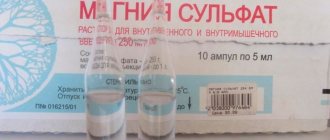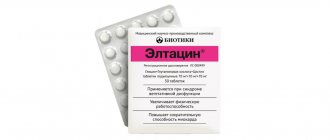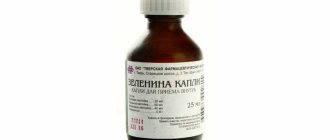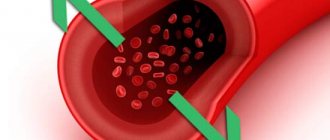Indications and contraindications for treatment with Pantogam
The instructions indicate certain pathological conditions for which the use of the drug is recommended. Pantogam tablets are approved for use in patients over 3 years of age:
- with reduced memory and mental performance, organic lesions of the brain, including head injury and the results of experienced neuroinfections;
- Westphal-Wilson, Unferricht-Lundborg disease, a combination of progressive choreic hyperkinesis and mental disorders;
- pathologies associated with changes in the cerebral vessels of the brain;
- epilepsy, which provokes inhibition of mental processes;
- neuroleptic syndrome, enuresis, frequent urination, urge incontinence;
- schizophrenia with organic cerebral insufficiency.
For children over three years of age, the medicine is recommended:
- with different degrees of severity of developmental delay: motor, mental, speech;
- tics, stuttering, cerebral palsy;
- hyperactivity syndrome, encephalopathy of the perinatal period.
Pantogam is contraindicated in patients:
- under 3 years old;
- women during pregnancy and breastfeeding;
- with individual allergies to the component composition.
The drug is not used for acute kidney diseases with a complex course.
Most patients undergo treatment without complications. Occasionally, adverse reactions may occur in the form of skin rash, runny nose, and conjunctivitis. If unusual symptoms appear, Pantogam should be discontinued or the initial dosage reduced.
Sometimes patients complain of problems with sleep phases, daytime sleepiness, or extraneous noise in the head. These clinical manifestations are short-term and disappear on their own after a few days from the start of therapy. Do not require changes to the treatment regimen.
Methods of therapy, dosages from the instructions for Pantogam
The tablets are taken half an hour after meals, in the first half of the day. Procedures should not be carried out after 16.00. The instructions for Pantogam mention the following conditions:
- a single dosage for adults does not exceed 0.25-1 g, daily dosage – 1.5-3 g;
- for children from the age of three - from 0.25 to 0.5 g per procedure, 0.75-3 g per day;
- therapy lasts 1-4 months, the period can increase to six months, after a 3-6 month break, manipulations can be resumed.
Daily dosages depend on the type of pathological process detected:
- combined treatment of epilepsy allows taking Pantogam in an amount of 0.75-1 g per day for one calendar year;
- when fighting neuroleptic extrapyramidal syndrome - 3000 mg for 2-3 months;
- extrapyramidal hyperkinesis with genetic diseases of the nervous system – 0.5-3 g for more than 4 months;
- consequences of neuroinfections and head injury – up to four times a day, 0.25 g;
- asthenia, mental and physical stress – 0.25 g three times a day;
- extrapyramidal syndrome due to antipsychotics - for adults, 0.5-1 g three times a day, for children - 0.25-1 g, with a duration of therapy of up to one quarter;
- tics in childhood – 0.25-0.5 g, up to 6 procedures per 24 hours, up to four months in a row;
- urinary disorders - adults 0.5-1 g three times a day, children - 0.25-0.5 g, treatment lasts for three months in a row.
Children with various pathologies of the nervous system are prescribed 1000-3000 mg of Pantogam, the exact dosage depends on age.
The standard treatment regimen requires a gradual increase in the dose of the drug over one week, the use of the maximum amount of medication for up to 40 days and a gradual reduction over 7 days, until the drug is completely discontinued. Repeated treatment is allowed only after a 1-3 month break.
Pantogam and Pantogam active are original domestic nootropic drugs that are successfully used in medical practice.
In 1969 in Russia V.M. Kopelevich and V.I. Gunar synthesized the calcium salt of D (+)-pantoyl-gamma-aminobutyric acid (the calcium salt of D-homopantothenic acid - the highest homologue of D (+)-pantothenic acid, in which β-alanine is replaced by γ-aminobutyric acid (GABA)) , which has neurotropic activity similar to GABA, but unlike GABA, it is able to penetrate the blood-brain barrier. Subsequently, based on the calcium salt of D-homopantothenic acid, the drug Pantogam was created in tablet form, which was approved in clinical practice in 1977. In 2002, PIK-PHARMA developed and released the drug Pantogam syrup 100 mg/ml for use in children.
Pharmacologically, only the D-isomer has been studied for a long time, but the homopantothenic acid molecule can exist in the form of two stereoisomers (D- and L-isoforms). Research conducted at the Research Institute of Pharmacology named after. V.V. Zakusov, showed that the D- and L-stereoisomers of homopantothenic acid complement each other’s action. In 2008, the PIK-PHARMA company registered a drug based on rac-hopantenic acid (D-, L-hopantenic acid) - Pantogam active.
Pantogam
(D-isomer of homopantothenic acid) and
pantogam active
(rac-hopantenic/D-, L-hopantenic acid) stimulate anabolic processes in neurons, increase the brain’s resistance to hypoxia and the effects of toxic substances, and reduce motor excitability. The spectrum of pharmacological effects of both drugs includes nootropic, antihypoxic, neuroprotective, anticonvulsant, antiasthenic, and vegetative stabilizing [1–4].
An important feature of Pantogam active is its ability to have a mild anxiolytic effect, which is explained by the presence of an L-isomer in rac-hopantenic acid that can interact with D2-dopamine receptors in the brain [5], providing greater affinity for GABA-B receptors and more active interaction with non-benzodiazepine GABA-A receptors. The ability of Pantogam active to provide a nootropic, mild anxiolytic and mild stimulating effect is due to the frequency of its use in clinical practice as a nootranquilizer.
It is important to note that the nootropic and anxiolytic effect of Pantogam active is not accompanied by the development of hyperstimulation syndrome, withdrawal or addiction, which is especially important with long-term use of the drug.
The mechanism of action of pantogam and pantogam active allows them to be combined with cardiological drugs, neuroleptics, thymoleptics, cerebroprotectors, lipid-lowering and anticonvulsants.
Use of Pantogam in children
In children's practice, pantogam has been used almost from the first days of its creation. G.S. Golosnaya [6] revealed the high effectiveness of Pantogam in the treatment of disorders of psychomotor development in children of the first year of life with chronic intrauterine hypoxia. The drug was prescribed in the form of syrup, 0.5 g 2 times a day for 56 days. Its higher effectiveness was established in comparison with Cortexin and Encephabol, as well as good tolerability and safety.
The feasibility of using Pantogam in children 3-5 years old with developmental dysphasia as monotherapy has also been established. For 2 months, 30 patients received a course of treatment with Pantogam (syrup, daily dose 500-600 mg), 20 patients formed the control group. During treatment, a significant improvement was achieved in indicators of expressive and impressive speech, as well as speech attention. In children receiving the drug, the volume of active vocabulary and the number of phrases in spoken speech increased more than 3 times, while in the control group it increased only 1.5 times. Parents noted a decrease in the severity of cerebrasthenic and psychosomatic disorders, motor awkwardness, hyperactivity, improvement in attention and general orderliness of behavior. The positive effect of pantogam on the formation of motor skills was also established.
The successful use of hopantenic acid in children as a cerebroprotector was demonstrated by A.M. Ovezov et al. [7] in children with congenital surgical pathology (varicocele, cryptorchidism, inguinal hernia). These patients underwent surgical operations with anesthesiological support.
Pantogam in school-age children, when prescribed from the postoperative period (at a dosage of 40 mg/kg), leveled out the effects of postoperative cognitive dysfunction by the time of discharge from the hospital, and 1 month after surgery, in 30% of patients while taking the drug, a significant increase in cognitive potential was observed compared to the original one.
Another point of application for hopantenic acid drugs is neurogenic bladder dysfunction, which continues to be one of the most pressing problems in pediatric urology for a long period [8]. Taking Pantogam expands the child's adaptive capabilities by normalizing the somatovegetative, cognitive and emotional components of mental activity. It has been established [8] that pantogam has a positive effect on the urodynamics of the lower urinary tract both at the central and peripheral levels and can be recommended both as a basic drug in the complex treatment of neurogenic bladder disorders and as a preventive drug during the rehabilitation period . Its pharmacological effects are due to a direct effect on the GABA receptor channel complex, which also has an activating effect on the formation of acetylcholine, causing inhibition of the pathologically increased vesical reflex and detrusor tone.
The advantage of using Pantogam is the presence of a pharmacological release form in the form of both tablets and syrup (100 mg/ml), which allows it to be used from the first days of life by children with perinatal stroke.
The range of clinical use of Pantogam in children includes: 1) cognitive impairment, including delayed psycho-speech development, speech disorders, including post-stroke, as well as early postoperative cognitive dysfunction; 2) movement disorders, delayed motor development; hyperkinesis (it can be used as long-term monotherapy for up to 4 months, as well as as part of complex therapy with tiopridal), correction of extrapyramidal side effects of neuroleptic therapy; 3) epilepsy (as part of complex therapy, since Pantogam has an anticonvulsant effect and does not cause a decrease in the threshold of convulsive readiness); 4) neurotic and neurosis-like disorders, emotional and behavioral disorders; 5) asthenic syndrome, decreased mental and physical performance (especially against the background of long-term rehabilitation); 6) autonomic dysfunction syndrome, including sleep disorders; 7) pain syndrome (as part of complex therapy for cervicalgia and cephalgia).
It should be added to the above that Pantogam is included in the clinical guidelines for the treatment of cerebral palsy (2014), as well as in the Federal standards of medical care of the Russian Ministry of Health for organic, including symptomatic, and mental disorders in connection with epilepsy. The main mechanisms of action of pantogam are a direct effect on GABA receptors and potentiation of GABAergic inhibition in the central nervous system.
In the course of recent work N.N. Zavadenko and E.V. Kozlov [9] confirmed the high therapeutic potential of Pantogam in the long-term treatment of attention deficit disorder in children (ADHD). Prescription of Pantogam in daily doses of 0.5-1.0 g in 2 doses led to a significant regression of the main symptoms of ADHD in the first 2 months of therapy, and according to the results of a survey of parents, a significant improvement in indicators of behavior and study at school, as well as the formation of basic life skills was established skills after 4-6 months of treatment.
The use of Pantogam and Pantogam active in the treatment of epilepsy and hyperkinesis
The risk of increased seizure readiness when using nootropic drugs is well known, which limits their widespread use in the treatment of cognitive and asthenic disorders in patients suffering from epilepsy or hyperkinetic disorders.
The presence of active nootropic and anticonvulsant actions in Pantogam and Pantogam in combination with a mild activating effect, as well as their ability to potentiate the effect of anticonvulsants and reduce the side effects of phenobarbital and carbamazepine, allow them to be used in patients with epilepsy and hyperkinesis in children and adults.
In 2015, the effectiveness of Pantogam was established [10] in children aged 4 to 7 years with epilepsy in combination with cognitive and speech disorders.
Before treatment with Pantogam, children were characterized by increased distractibility, decreased attention, sleep disturbances (shallow sleep, night terrors, sleep talking), emotional lability, increased fatigue, they also suffered from headaches, increased anxiety, and fears.
Varying degrees of effectiveness of hopantenic acid were noted in 77.5% of children. All children with epilepsy after taking Pantogam for 2 months showed good tolerability; No complications or increased frequency of epileptic seizures were detected. It was found that as a result of taking hopantenic acid, 7.5% of children also experienced an improvement in the electroencephalogram (EEG) in the form of a decrease in diffuse changes and a delay in the maturation of the basic rhythm; in 3 (7.5%) children, the EEG began to correspond to the age norm.
In another double-blind, placebo-controlled study [11], Pantogram Active was used in patients 21–49 years of age with symptomatic partial epilepsy due to traumatic brain injury (TBI), vascular disease, and surgical removal of a brain tumor. Pantogam active was used in combination with anticonvulsant therapy (topiramate, carbamazepine, oxcarbazepine, valproate). It was prescribed at an average daily dose of 1200-1800 mg/day for 8 weeks. During treatment, a decrease in the severity and frequency of epileptic seizures was recorded by 50-75% in 22.2% of patients (in the placebo group - 0), by more than 25-50% - in 44.4% of patients (in the placebo group - only in 16.7% of patients). In general, 72.1% of patients taking Pantogam active showed a reduction in epileptic seizures. An improvement in the tolerability of antiepileptic therapy and the state of cognitive functions was also noted (after 8 weeks of therapy, long-term memory and mental performance improved in 78.6% of patients). In 66% of patients, in addition, there was an improvement in their emotional state (reduction of anxiety on the HADS scale). According to the CGI scale, the effectiveness of treatment was stated in 72.2% of patients. An improvement in quality of life was also noted. As in other studies, attention was paid to the good tolerability of the drug.
Also of interest was the use of Pantogam active in 44 patients with cryptogenic partial, symptomatic partial, idiopathic generalized epilepsy in a state of complete or partial remission [12]. Patients were prescribed treatment with valproic acid, oxcarbazepine, carbamazepine, levetiracetam in mono- or polytherapy in combination with Pantogam active at a dose of 900 mg/day in 3 doses for 45 days. A positive effect of Pantogam Active on psychophysiological parameters was established according to EEG and psychological tests, allowing to assess the structure, volume of memory and attention; its antiasthenic effect was also revealed. During therapy with the drug Pantogam active (on the 14th day) and upon completion of the course of its use (on the 45th day), the patients themselves noted normalization of memory, improved attention and increased stability. It should be noted that the drug was well tolerated by patients, did not cause disruption of remission, and in the group of patients with ongoing epileptic process with partial remission, pantogam did not lead to an increase in seizures.
It has been established [13, 14] that pantogam active, like pantogam, can be successfully used in neurological practice for the treatment of hyperkinesis. In a double-blind, placebo-controlled study, Pantogam active was prescribed [13] at an average daily dose of 900–1800 mg to patients with dystonic hyperkinesis of the face and neck (oromandibular dystonia, spastic torticollis, blepharospasm lasting more than 6 months) and 2 types of effects were noted. The first, most rapid effect was realized by the end of the 2nd week in the form of a reduction in psychopathological symptoms, a decrease in the level of anxiety, irritability, and improved sleep and persisted throughout the duration of taking the drug. The second effect of the drug was observed 2-2.5 months from the start of therapy and was expressed in a decrease in the severity of dystonic hyperkinesis (reduction in the duration and frequency of blepharospasm and oromandibular dystonia, decrease in the degree of tilt and rotation of the head, tremor, feelings of tension, pain and stiffness in the neck muscles ). The average score on the dystonia severity scale during this period decreased from 6.8 to 4.9 points, on the torticollis severity scale - from 10.5 to 8.3 points, and after 3 months - to 3.2 and 5.3 points, respectively. and at the end of treatment it was approximately 2 times less than in the placebo group. No deterioration of the condition was recorded in any patient. Analysis of the effectiveness of the therapy by the end of the 3rd month (12th week) showed that clinical improvement on the CGI-I scale was noted by 57% of patients receiving Pantogam active. The best effect was observed in patients with a short disease duration of 1.5-3 years. In a number of patients, the administration of Pantogam Active made it possible to increase the dose of drugs traditionally used to treat dystonia (clonazepam, cyclodol, tiapridal, baclofen) by reducing the severity of their side effects.
The use of Pantogam active in the treatment of mental pathologies of various origins
Clinical studies of Pantogam Active have shown its effectiveness in patients with asthenoneurotic symptoms, anxiety and cognitive disorders in patients with organic brain diseases of various origins, as well as in the structure of somatoform, stress-related and neurotic disorders.
When treated with Pantogam Active, a number of studies [15-24] noted a reduction in psychopathological symptoms in patients with asthenic, anxiety-depressive disorders, and post-traumatic stress disorder. Its anxiolytic effect has been established in patients with increased levels of anxiety due to cardiovascular diseases. Pantogam active, improving the cognitive functions and emotional state of patients, increases the level of their social adaptation, influencing the area of performance and daily functioning.
Pantogam active for neurasthenia
L.S. Kanaeva et al. [15] conducted a randomized, double-blind, placebo-controlled study of the effectiveness and safety of Pantogam active at a daily dose of 900–2100 mg as monotherapy for 6 weeks in patients aged 18 to 65 years (average age 48 years) with asthenic organic disorders genesis or with neurasthenia, lasting an average of 4.9 months. The effect of therapy was established (from the 14th day), manifested in the improvement of all components of the asthenic symptom complex, and it persisted throughout the entire course of therapy. Patients noted an improvement in general well-being, mood and performance, motivation, and social adaptation. Improved indicators of social adaptation in neurasthenia and organic asthenic disorder were noted already from the 14th day. Statistically significant differences between the Pantogam Active group and placebo in organic neurasthenia were recorded already on the 14th day ( p
<0.05), and for neurasthenia - on the 28th day (
p
<0.05).
The dynamics of cognitive functions by the end of treatment in patients with organic asthenia and neurasthenia while taking Pantogam Active was significantly higher (by 40%; p
<0.01) than in the placebo group (by 15%;
p
<0.05).
There was also a significant ( p
<0.05) improvement in the state of the autonomic nervous system and a decrease in the manifestations of autonomic dysfunction from the 14th day of treatment. Statistical differences between the placebo and active therapy groups were observed throughout the treatment period. Thus, this study showed antiasthenic, mild activating, cognitotropic and vegetostabilizing effects of the drug, which have significant advantages compared to placebo. Pantogam active was noted to be well tolerated.
Pantogam active for post-traumatic stress disorder
In the study by A.I. Paltseva et al. [16] studied the effectiveness of Pantogam active (in an average daily dose of 900 mg) in combat veterans who had suffered closed head injuries of mild and moderate severity, with chronic pain syndrome of various localizations (headache, pain in the lower back, neck, joint pain, etc. .) and moderate to severe post-traumatic stress disorder. In most cases, its effect was expressed in a positive effect on memory, reducing anxiety levels and reducing emotional problems in everyday life, improving quality of life, and increasing tolerance to chronic pain syndrome.
Pantogam active for chronic cerebral ischemia with emotional and cognitive impairment
Currently, positive experience has been accumulated in the clinical use of Pantogam active as a drug with a neuroprotective effect in various forms of cerebrovascular diseases [17—27].
Pantogam active increases the brain's resistance to hypoxia and the effects of toxic substances, activates anabolic processes in neurons and, depending on the severity of cognitive impairment, can be prescribed in mono- or complex therapy for vascular cognitive disorders that have developed as a result of damage to the blood supply zone of deep perforating arteries, periventricular areas brain, as well as after TBI. As studies have shown, the drug is effective in monotherapy of mild and moderate cognitive impairment and its long-term use does not lead to the development of hyperstimulation, which is important for patients with vascular pathology.
Pantogam active can be used for all types of discirculatory encephalopathy. A number of studies [17, 18, 25—27] have revealed that in patients with cerebrovascular accidents, including those with a history of stroke, the use of the drug improves hand-eye coordination, increases the level of attention and the volume of short-term visual memory, mental performance, as well as improved emotional state. In this case, the fact that there is no negative effect on blood pressure (BP) in patients is important. The researchers noted that against the background of complex therapy with the inclusion of Pantogam active, there was a decrease in the frequency of psychogenically provoked rises in blood pressure and improved control of blood pressure levels.
The therapeutic efficacy and favorable safety profile of Pantogam active at an average daily dose of 1200 mg was demonstrated in a double-blind 8-week placebo-controlled study [17] in patients with grade I-II discirculatory encephalopathy and mild/moderate cognitive impairment or early stage dementia. Already from the 1st week, patients noted an improvement in speech, verbal associations, a decrease in anxiety, difficulty falling asleep, and from the 4th-6th week - an improvement in general well-being and cognitive functions of the neurodynamic type. Clinically significant improvement in cognitive indicators according to the Wechsler tests, Schulte tables, the “10 words” test, the memory self-assessment questionnaire and some other tests, along with a reduction in psychopathological astheno-anxiety symptoms and a general improvement in the well-being of patients, was significantly more pronounced during treatment with Pantogam Active as 30- th, and on the 56th day of therapy. There was an increase in the effectiveness of therapy on the CGI-I scale in the category of “very good” and “good” improvement on the 30th day in 67% of patients, and on the 56th day in 88% of patients taking the drug.
The high effectiveness of Pantogam active (at a dose of 0.9 g/day for 4 weeks) was established [28] in women with chronic cerebral ischemia and anxiety-depressive disorders against the background of concomitant somatic pathology in women with menopausal syndrome. Therapy with Pantogam active in a daily dose of 900 mg for 4 weeks led not only to a complete reduction of anxiety and depressive symptoms, but also to an increase in mental performance, improved memory and attention, normalization of vegetative manifestations, emotional state and, in general, in 93% of patients - a decrease in the degree severity of psychoemotional and neurovegetative manifestations of CS according to the Kupperman–Uvarova index. These results provide grounds for the use of Pantogam active in the treatment of menopausal syndrome.
The peculiarities of the effects of Pantogam active allow it to be combined with various psychotropic drugs, including antidepressants.
A successful example is the inclusion of Pantogam active (in an average daily dose of 1.2 g for a short period of 21 days) in the treatment of anxiety and depressive disorders of various origins in patients with chronic cerebral ischemia [27]. As a result of the study, in patients with organic pathology of the central nervous system, its ability to potentiate the effect of antidepressants (escitalopram, paroxetine, fluvoxamine, sertraline and venlafaxine) and to develop more pronounced cognitotropic, antidepressant and anxiolytic effects was revealed, even with a short course of treatment. In mixed anxiety and depressive disorder, the combined use of Pantogam Active with antidepressants demonstrated positive cognitive effects and improved quality of life indicators. When taking Pantogam active in combination with SSRI antidepressants, the total number of adverse events, such as drowsiness and headache, decreased [27].
Pantogam active in the treatment of mental disorders in patients with cardiovascular diseases
Pantogam active has found use in patients with hypertension, chronic heart failure, cardioneurosis, coronary heart disease (CHD), patients after acute coronary syndrome, chronic heart failure of functional class II-III as a drug with a bimodal effect (nootropic and anxiolytic effect) and allowing to improve not only the functional state of the central nervous system in conditions of hypoxia and the effect of a large number of cardiotropic drugs, but also the emotional state of patients, which not only reduces the drug burden on the patient, but also helps to increase the effectiveness of antihypertensive and cardiotropic therapy by increasing emotional stability and reducing psychogenic (psychosomatic) component in the development and progression of cardiovascular pathology [18—24, 29, 30].
Thus, in one of the studies [20], while taking Pantogam active (average effective dose 1.8 g/day) in patients with cardioneurosis in a daily dose of 0.6 to 2.4 g, a reduction in the severity of psychopathological syndromes, including anxiety, was observed. somatoform disorders, hypothymia, asthenia, memory and attention disorders. Only when stopping panic attacks was its minimal therapeutic effect noted. Significant positive dynamics of asthenic disorders, memory and concentration problems were recorded already in the 3rd week of treatment with the drug and intensified by the 6th week, while the anxiolytic effect appeared already in the 1st week of therapy. At the same time, a mild activating effect of the drug and the absence of any serious side effects that would limit its further use in such pathologies were noted.
A study was also conducted [23] on the effectiveness of Pantogam Active in a hospital setting in patients diagnosed with coronary artery disease, acute coronary syndrome, uncomplicated myocardial infarction, and unstable angina. It was used in these cases in a daily dose of up to 1800 mg, starting from the 7-10th day and for 6 weeks after hospitalization. A decrease in mild and moderate manifestations of anxiety-depressive and anxiety disorders on a number of scales was established, as well as a preventive effect of pantogam in relation to the development of psychopathological symptoms.
In another study [22], against the background of 6-week monotherapy with Pantogam active at a dose of 0.6-2.4 g/day, 74.5% of patients with cardiovascular pathology (hypertension, coronary artery disease, atrial fibrillation) showed a decrease in anxiety levels and depression and psycho-emotional stress experienced by patients, comparable in effectiveness to the effect of antidepressants. By the end of treatment, the effectiveness of therapy with Pantogam Active remained.
There is also evidence in the literature [19, 20, 23] of the effectiveness and safety of Pantogam active in patients with stage I-III hypertension, suffering from asthenic (somatogenic asthenia, neurasthenia), anxiety-depressive disorders and disorders of adaptive reactions.
During treatment with Pantogam Active, there was a decrease in the severity of psychopathological disorders (anxiety-depressive symptoms), along with a general improvement in well-being in 63.3% of patients already by the beginning of the 2nd week of therapy, it reached statistically significant changes by the 4th week of treatment and maximum severity - by the end of the 6th week of treatment. By the time the study was completed, the response rate was 76.7% according to the Hamilton scale and 66.7% according to the Spielberger test. The decrease in the severity of anxiety-phobic with panic attacks and hypochondriacal disorders with an average duration of about 9.6 months was moderate. A positive effect of the drug on the level of both situational and personal anxiety was noted. At the same time, a favorable cardiac safety profile of the drug was established, as well as its positive effect on the main hemodynamic parameters, including a decrease in average blood pressure values, the frequency of subjectively recorded psychogenically provoked rises in blood pressure and hypertensive crises, as well as angina attacks.
The above studies also showed the safety of long-term (6-12 weeks) use of Pantogam active and the absence of hyperstimulation or addiction syndrome in patients with stage I-II hypertension and/or coronary artery disease (angina pectoris I-II functional class, post-infarction cardiosclerosis). While taking the drug, starting from the 1st week, the development of a therapeutic effect was observed throughout treatment, in contrast to the reversible effect of phenotropil, 1 month after taking which the patients’ anxiety increased. At the same time, while taking Pantogam active, a significant ( p
<0.001) reduction in the frequency of psychogenic increases in blood pressure by almost 3 times (from 7.3 to 2.1) and by almost 2 times of angina attacks (from 6.9 to 3.1) [23].
The safety of using Pantogam active in an average daily dose of 900 mg as a drug of choice with bimodal nootropic and tranquilizing activity for the treatment of cognitive and anxiety disorders in patients with stage II-III arterial hypertension was shown by A.B. Smulevich et al. [18]. In this study, the therapeutic effect of the drug developed already during the 1st week of treatment and after 4 weeks of treatment, a significant reduction in anxiety disorders (88% of respondents with a decrease in the level of anxiety on the Sheehan scale by more than 50%) and cognitive impairment (78% of respondents) was noted at the end of treatment, improvement in cognitive functions in general in 96% of patients). An interesting finding in this study was the fact that systolic (by 24% from baseline compared to 14% in the control group) and diastolic blood pressure decreased while taking Pantogam Active (by 12% from baseline compared to 7% in the control group) , as well as reducing the frequency of psychogenic rises in blood pressure in patients within 2 weeks after discharge from the hospital.
The safety of using Pantogam active was also noted in patients with chronic heart failure [24]. We treated 83 patients with functional class II-III. As a result of an 8-week course of use of Pantogam active in an average daily dose of 1200 mg, the severity of anxiety and depressive disorders significantly decreased, mental performance and general well-being of patients improved. An instrumental study recorded an improvement in the autonomic regulation of cardiac functions due to improved autonomic balance, leading to a decrease in the frequency of supraventricular and ventricular arrhythmias (by almost 18%), as well as an increase in the patients’ tolerance to physical activity (increasing the 6-minute walking distance from 288 to 335 m on average), which was accompanied by a significant improvement in the quality of life of patients.
Thus, the studies have shown that the use of Pantogam Active in patients with cardiovascular diseases allows it to be used not only as a drug to improve mental performance and emotional status of patients, but also as a drug that opens up alternative possibilities for increasing the effectiveness of cardiotropic and antihypertensive therapy, as well as the quality of life of cardiac patients.
While taking Pantogam active, there is a clear reduction in mild and moderate manifestations of psychopathological symptoms (somatogenic asthenia, neurasthenia, anxiety, anxiety-depressive, somatoform disorders). At the same time, the drug has a moderate effect on the severity of anxiety-phobic disorders that occur with panic attacks, and long-term (over 6 months) hypochondriacal disorders [23].
Use of Pantogam and Pantogam active for schizophrenia
In these cases, the effect of the drugs Pantogam and Pantogam Active in combination with antipsychotics was studied. A positive neuroprotective effect of the drugs was established not only in relation to the cognitive functioning of patients, but also in reducing the frequency and severity of side effects of neuroleptic therapy, as well as increasing its effectiveness.
In particular, according to N.P. Juga et al. [31], the use of pantogam in patients with paranoid schizophrenia in an average daily dose of 1500 mg potentiates the antipsychotic therapeutic effect of the neuroleptic haloperidol, improving the formation of reciprocal relationships between the dynamics of positive and negative symptoms and improves overall cognitive functioning in patients during the treatment of exacerbation of schizophrenia.
Other studies [32-35] showed that the use of Pantogam Active helped reduce the incidence of neuroleptic extrapyramidal disorders both in cases of acute psychosis (daily dose of Pantogam Active 900 mg for 4 weeks) [35] and in the period of drug remission of schizophrenia with negative symptoms (average daily dose of Pantogam active 1500 mg for 24 weeks) [32, 33]. It was noted that Pantogam active helps to reduce the dose of correctors for extrapyradical disorders [32, 33, 35].
In addition, it was found that the use of Pantogam active in a dose range of 1.2-1.8 g/day not only reduces the incidence and severity of symptoms of secondary negative disorders (neuroleptic depression, cognitive impairment), but also potentiates the therapeutic effect of neuroleptics on the manifestations of productive , primary negative and general psychopathological symptoms [32, 33].
According to V.E. Medvedeva et al. [34], the inclusion of Pantogam Active in the complex therapy of schizophrenia with a predominance of negative symptoms makes it possible to achieve an improvement in the condition of patients at an earlier time (on the 8th week compared to the 16th week in the control group), as well as significantly reduce the incidence and severity of conditioned antipsychotic treatment of secondary negative disorders. In this regard, the drug, according to the researchers, can be recommended as an additional drug for long-term (at least 24 weeks) treatment of schizophrenia with typical antipsychotics. An important evidence of the positive effect of Pantogam Active on the tolerability of neuroleptic therapy is the fact that in the main group all patients completely completed the study, and in the control group 20% of patients dropped out of the study due to the development of subjectively intolerable negative phenomena (parkinsonism, dyskinesia, excessive sedation).
As the study by A.S. showed. Tiganova et al. [35], the use of Pantogam active in a daily dose of 900 mg for 4 weeks in patients in the acute period of paranoid schizophrenia not only improved the tolerability of neuroleptic therapy, but also reduced the incidence of primary and secondary extrapyramidal neuroleptic disorders by 3 times, and made it possible to reduce the dose of their correctors (trihexyphenidyl, cyclodol) by 38.5%.
Thus, scientific research and experience in the practical use of Pantogam and Pantogam active have shown the effectiveness and safety of these drugs in patients with various pathologies. Pantogam asset attracts special attention. Due to the content of rac-hopantenic/D-, L-hopantenic acid, it has a unique spectrum of pharmacological effects - nootropic, anticonvulsant, mild activating, combined with mild anxiolytic effects. As studies have shown, this allows its long-term use as a drug with bimodal activity when it is necessary to improve not only cognitive functions, but also the emotional state in patients 18 years of age and older in psychiatric, neurological and cardiological practice for diseases and conditions such as anxiety / anxiety-depressive disorders, dyscirculatory encephalopathy, coronary artery disease, chronic heart failure, arterial hypertension, epilepsy, head injury, schizophrenia, as well as cognitive impairment in the structure of neurological and psychogenic deficits.
The authors declare no conflict of interest.







